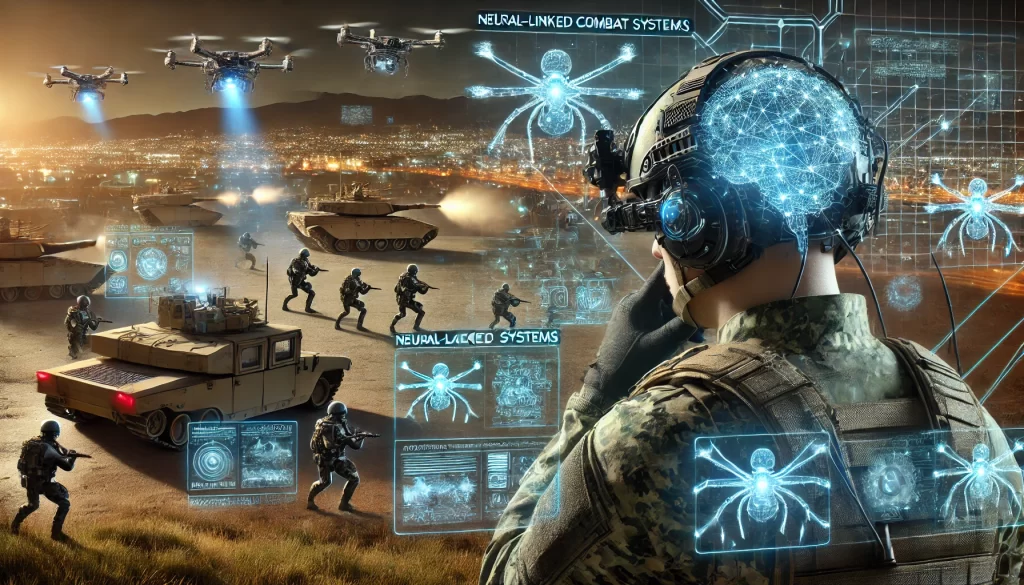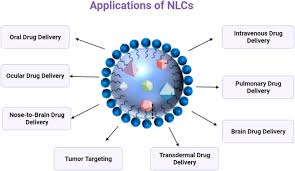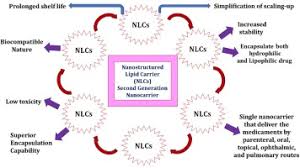
Introduction
Neural-Linked Combat Systems (NLCS) represent a futuristic advancement in military technology, integrating brain-computer interfaces (BCIs) with AI-driven warfare systems. This technology aims to enhance soldiers’ battlefield performance by enabling them to control weapons, drones, and robotic units using neural signals. With rapid developments in neuroscience and artificial intelligence, NLCS has the potential to revolutionize combat operations, making warfare faster, more precise, and less dependent on traditional control methods.
How NLCS Works
NLCS operates by establishing a direct neural interface between the human brain and military systems. The process involves:
- Brain-Computer Interface (BCI): A non-invasive or implantable neural sensor detects and translates brain signals into digital commands.
- AI Integration: Advanced artificial intelligence assists in processing neural inputs, optimizing commands for drones, weapons, and communication systems.
- Real-Time Tactical Feedback: Soldiers receive instant data analysis, enemy movement predictions, and strategic suggestions directly through AR (Augmented Reality) displays or neural feedback.
- Autonomous Combat Coordination: AI-enhanced decision-making allows multiple robotic units and autonomous drones to operate in coordination with human commanders.
Potential Applications
1. Mind-Controlled Drone Operations
Soldiers could control drone swarms using thought alone, enabling real-time reconnaissance, target tracking, and air support without manual input.
2. AI-Assisted Decision-Making
By analyzing a soldier’s cognitive state, AI can provide instant tactical suggestions, such as the best cover positions, threat prioritization, and counter-strategy recommendations.
3. Augmented Reality (AR) Warfare
AR-powered NLCS would allow soldiers to visualize real-time battlefield data, including enemy positions, mission objectives, and threat analysis, through neural-linked HUDs (Heads-Up Displays).
4. Cyber Warfare Enhancements
NLCS could be used to enhance cybersecurity operations, allowing human operators to conduct complex cyberattacks or defensive measures through neural commands.
5. Advanced Weapon Systems Integration
Neural-linked firearms, tanks, or missile systems could be operated through thought commands, allowing for faster reaction times and increased combat efficiency.

Benefits of NLCS
- Enhanced Reaction Speed: Eliminates the delay between decision-making and execution, giving soldiers an instant tactical advantage.
- Hands-Free Combat Operations: Soldiers can operate multiple devices simultaneously without physical controls.
- Reduced Cognitive Load: AI-powered support systems analyze data and provide optimized recommendations, reducing stress on soldiers.
- Seamless Human-Machine Collaboration: Allows for better coordination between soldiers and autonomous systems, leading to more efficient battlefield tactics.

Challenges and Ethical Concerns
Despite its advantages, NLCS presents several technical, ethical, and security risks:
- Cybersecurity Threats: If hacked, neural-linked systems could be exploited by enemy forces.
- Privacy and Ethical Concerns: Brain-computer interfaces may raise issues related to mental privacy and manipulation risks.
- AI Dependence: Over-reliance on AI decision-making could reduce human autonomy and judgment in combat situations.
- Physiological Risks: Long-term effects of BCI implants on brain function and cognition are still under research.
Future of NLCS
The future of Neural-Linked Combat Systems will likely see improvements in:
- More advanced non-invasive BCIs that reduce the need for implants.
- AI-driven predictive warfare models that anticipate enemy movements before they happen.
- Secure, quantum-encrypted neural networks to prevent hacking and cyber threats.
- Enhanced human-AI collaboration where soldiers act as battlefield strategists while AI executes tactical operations.
Conclusion
NLCS represents one of the most futuristic and groundbreaking advancements in modern warfare. By integrating brain-computer interfaces with AI-powered combat systems, NLCS has the potential to redefine military strategy, decision-making, and battlefield efficiency. However, ethical concerns, cybersecurity threats, and AI dependence must be carefully addressed to ensure responsible and secure implementation. As technology progresses, the fusion of human cognition and artificial intelligence will likely become a critical component of next-generation warfare.

